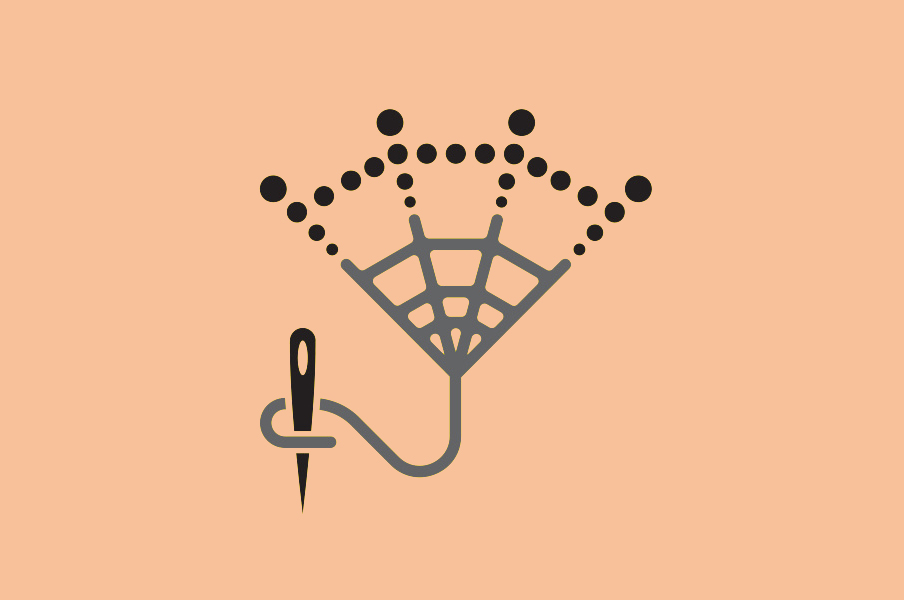Contents
As one of the biggest industries in the world, projected to rack up to $3.3 trillion by 2030, it’s surprising to learn that the way fashion operates today hasn't changed that much in the past twenty years.
This is, in part, because it's still easy to source low-cost manual labor in many countries and to outsource any pricey production costs. However, the rising concerns about fair wages, pollution, as well as the need to satisfy the hyper-connected consumers of today, have given way to new exciting technologies.
We do, indeed, live in the "insta-age" of technology. Customers have been trained to expect instant access to the latest trends as soon as they hit the catwalks, thanks to social media. Simultaneously, younger generations seeking to stand out from the crowd seek products that can be tailored to their specific needs and preferences. Furthermore, 'mass-produced' or 'fast-fashion' clothing appears to be losing favor.
As this trend continues, it becomes increasingly difficult for companies and brands to continue producing large quantities of apparel months in advance, with no guarantee of how well it will sell. In this fast-changing modern environment, those brands that pick up the pace and become more responsive to market needs will be the likely winners.
As customers' actual lives grow more entwined with the digital world, many designers and businesses must embrace cutting-edge technology to push the boundaries of manufacturing, production, marketing, and wearability. We've produced a list of the major tech breakthroughs in fashion today, ranging from artificial intelligence to the advent of mobile shopping, 3D printing, and blockchain.
Artificial intelligence (Ai)
In recent years, brands have used AI to improve the shopping experience of their customers, analyze data, increase sales, forecast trends, and provide inventory-related guidance.
Artificial Intelligence (AI) refers to the simulation of human intelligence in machines designed to learn, reason, and solve problems. In the fashion industry, AI is driving significant transformation by enhancing creativity and streamlining processes, from product design to customer engagement. Traditional fashion styles can take 3 to 8 months to develop, but AI accelerates this process, reducing labor costs and minimizing the need for physical samples.
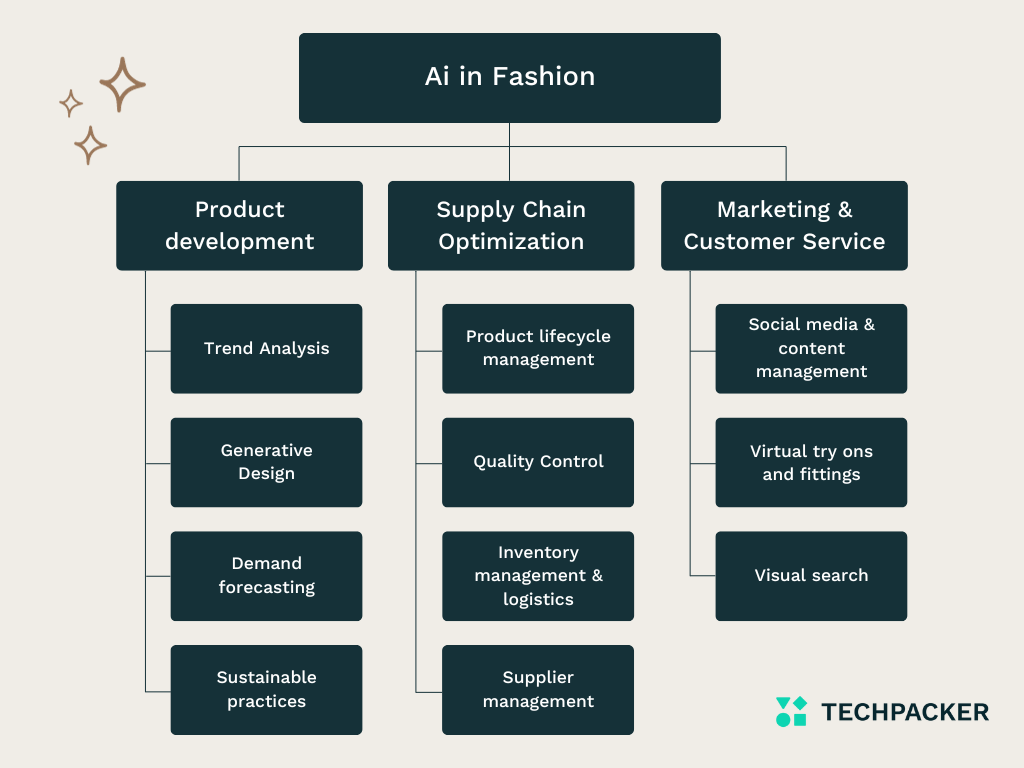
AI is transforming the fashion business by streamlining operations such as product development, supply chain optimization, and marketing. Tools such as trend analysis, generative design, inventory management, and virtual try-ons improve creativity, efficiency, and sustainability. Generative AI shortens design deadlines, minimizes human labor, and decreases costs, whereas chatbots and algorithms offer individualized consumer experiences.
AI also transforms trend forecasting and supply chain management, providing firms with real-time data to help them plan styles and quantities efficiently. Businesses that integrate inventory tracking with AI's predictive technologies get a competitive advantage in staying ahead of trends.
To dive deeper into how AI is reshaping the fashion landscape, check out our comprehensive guide.

The British fashion label STITCH FIX, has come up with an automated wardrobe planning tool that, using analytics, records its female customers’ purchases and introduces them to a virtual wardrobe. The platform also allows women to create looks from their wardrobes and even choose from over 10,000 shops.
Meanwhile, the personalization platform TRUEFIT employs an online fit engine that helps users find an adequate fit with brands and new styles on the market.
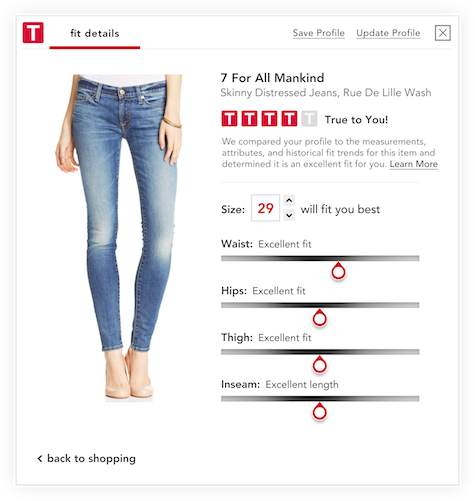
Intelligent, data-driven AI solutions are changing inventory management. Real-time tracking, demand forecasting, and faster production and delivery have greatly improved businesses with automated inventory management software. AI's inventory dynamics and stock level variations understanding is revolutionary. Advanced AI-driven inventory management solutions like SkuVault supports real-time inventory tracking, demand forecasting, and smart reorder points. SkuVault enables organizations to eliminate overstock and stockouts, streamline warehouse operations, and increase order accuracy.
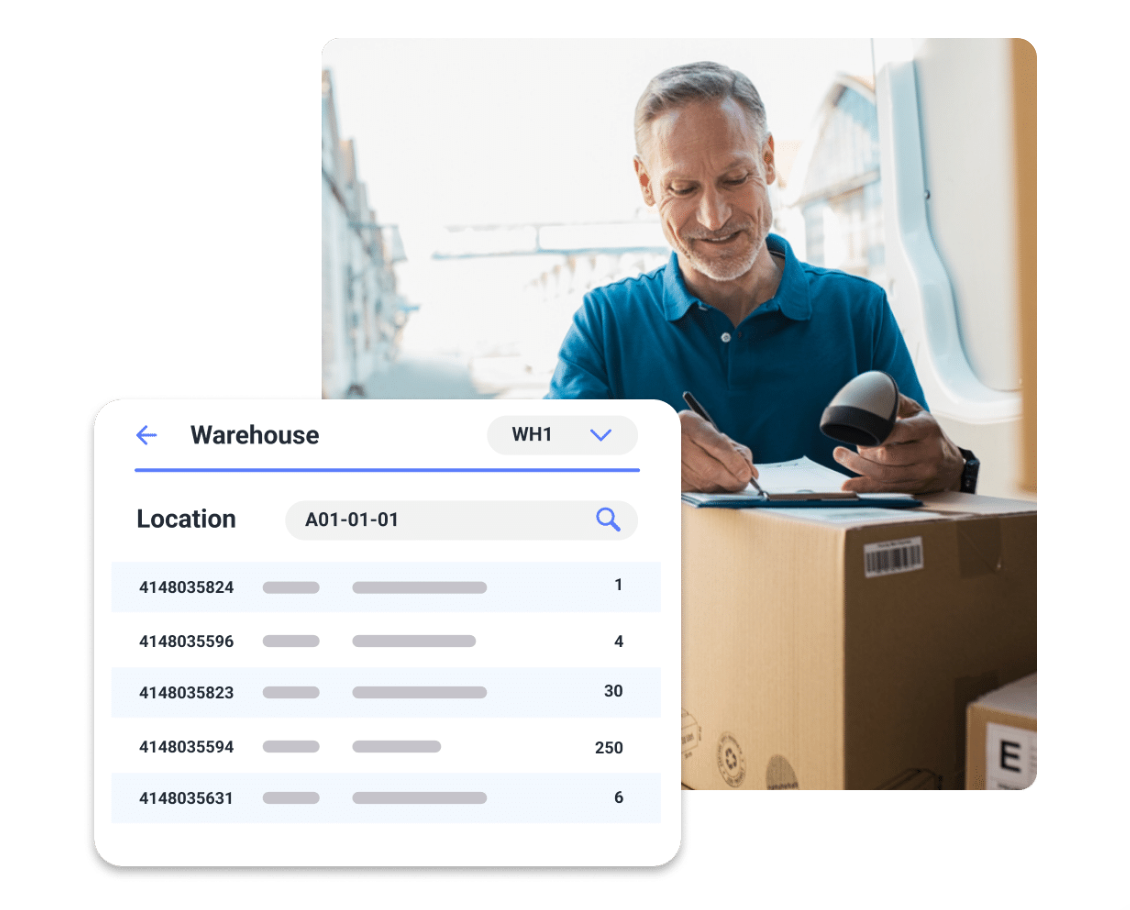
Furthermore, AI's predictive powers are being applied to real-time trend analysis. Platforms such as Intelligence Node, allows users to track trends in real time. Customers can enter specific keywords, user navigation patterns, price points, and more. Historically, fashion trend forecasting solely relied on prior trends to predict the future. New technologies like Heuritech define audience panels on social media. To predict future trends, it applies image recognition technology to social media pictures to access shapes, prints, colors, and attributes of fabrics.
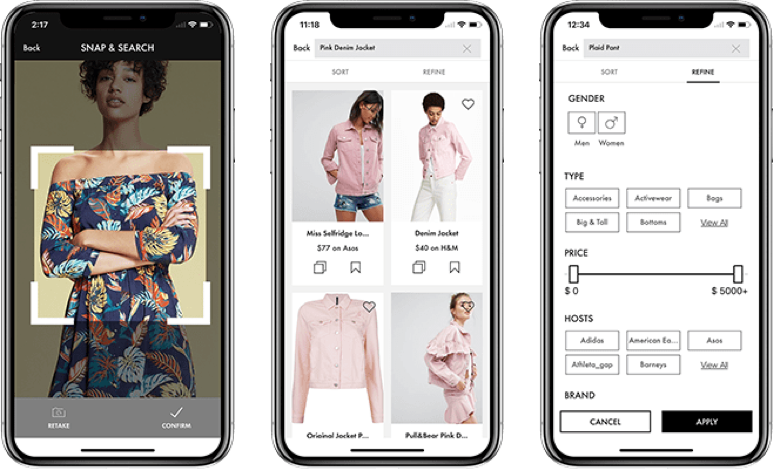
Now, customers can “try on designs” before making their purchases. Some brands, such as Tommy Hilfiger and Gucci, are offering digital showrooms to gauge the market's appetite. Some, like Taylor Stitch, allow customers to pre-order digital designs before they go into production. Likewise, many online-only eyewear companies such as Firmoo and Glasses Direct are also offering a digital ‘try-before-you-buy’ service that lets consumers visualize the frames on their faces before committing.
Partnerships such as Google and Zalando and collaborative projects like “Reimagine Retail” between IBM and the Fashion Institute of Technology uses neural networks and high-tech AI tools to learn client preferences and generate designs based on style trends, colors, and textures.
These technologies highlight how AI is the bastion of future developments in the fashion industry, shaping everything from trend forecasting to how consumers may actually see and buy products.

Innovative and Sustainable Fabrics
The fashion industry is witnessing a fabric innovation revolution, fueled by rising demand for sustainability, technology integration, and one-of-a-kind design options. As sustainability becomes more important to both customers and brands, novel materials emerge as the future of fashion, providing new, eco-friendly solutions that push the boundaries of innovation and performance.
Novel fabrics, made using advanced technology and innovative fibers, offer new possibilities in style and performance. These materials often include biodegradable, recyclable, or bio-based components, making them eco-friendly and cutting-edge. Sustainable fabrics prioritize reducing environmental impact, using resources like organic cotton, hemp, and recycled materials. Together, novel and sustainable fabrics are shaping the future of fashion, blending innovation, style, and responsibility.
A significant area of research is the creation of lab-grown leather, a more ethical and environmentally friendly alternative to traditional leather. Startups like Modern Meadow are pioneering the development of lab-grown leather that does not harm animals, answering concerns about the environmental effect of animal-derived items. Similarly, firms such as Bolt Threads and EntoGenetics are redefining fabric design using super-strong spider silk, which is biodegradable and durable enough for a variety of fashion uses.
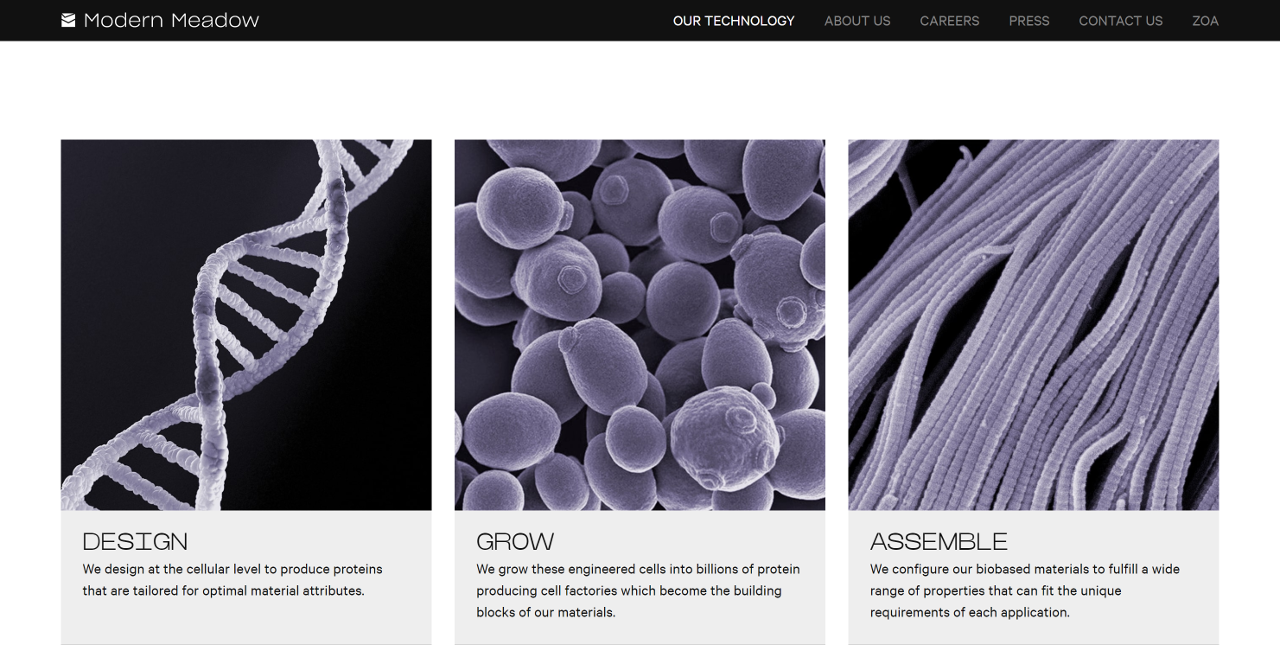
Beyond traditional fabrics, smart textiles are making waves by incorporating cutting-edge technologies into the fibers themselves. These textiles, which are frequently enhanced with nanotechnology or conductive threads, provide features such as temperature control to adapt to changing weather, moisture-wicking properties for comfort during physical activity, and even activity monitoring capabilities, making them ideal for the thriving sportswear and athleisure markets. Smart fabrics are predicted to be a prominent trend in 2025 and beyond, as demand for health and fitness-focused clothes grows.
Another significant discovery is 3D-printed fabrics, which enable designers to create one-of-a-kind, bespoke textiles with rich patterns and textures. Designers can use computer software and 3D printing technology to print cloth from synthetic fibers such as polyester, nylon, or elastane, creating limitless possibilities for individualized and avant-garde fashion. This technology enables designers to include components such as pockets and closures directly into the fabric, minimizing the need for additional materials and labor.
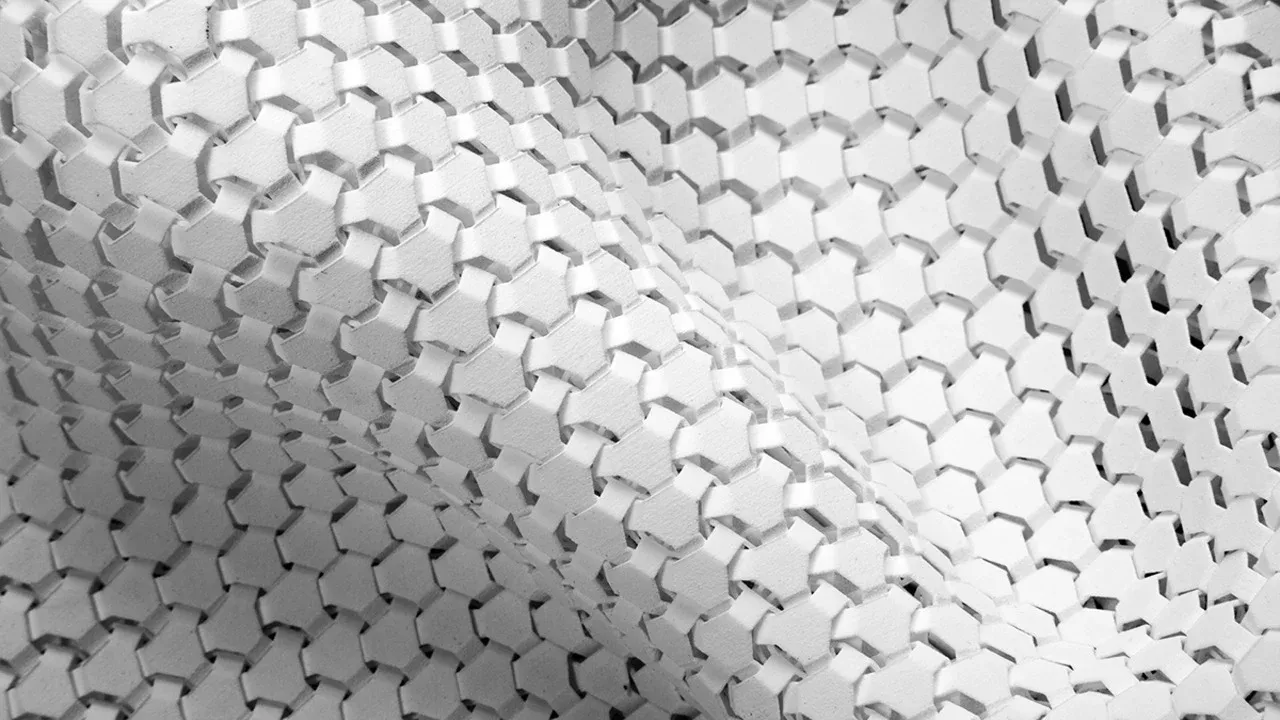
Moreover, Furthermore, circular textiles are altering the industry by encouraging a more sustainable, closed-loop model. With billions of clothes ending up in landfills each year, circular fashion aims to reduce waste and resource inefficiency by creating clothing that can be reused, repaired, repurposed, or biodegraded. This approach not only minimizes dependency on virgin materials, but also encourages brands to reconsider their design and manufacturing processes. Leading brands such as Patagonia and H&M are driving initiatives such as repair programs, garment recycling, and closed-loop technologies to extend garment life and reduce waste.
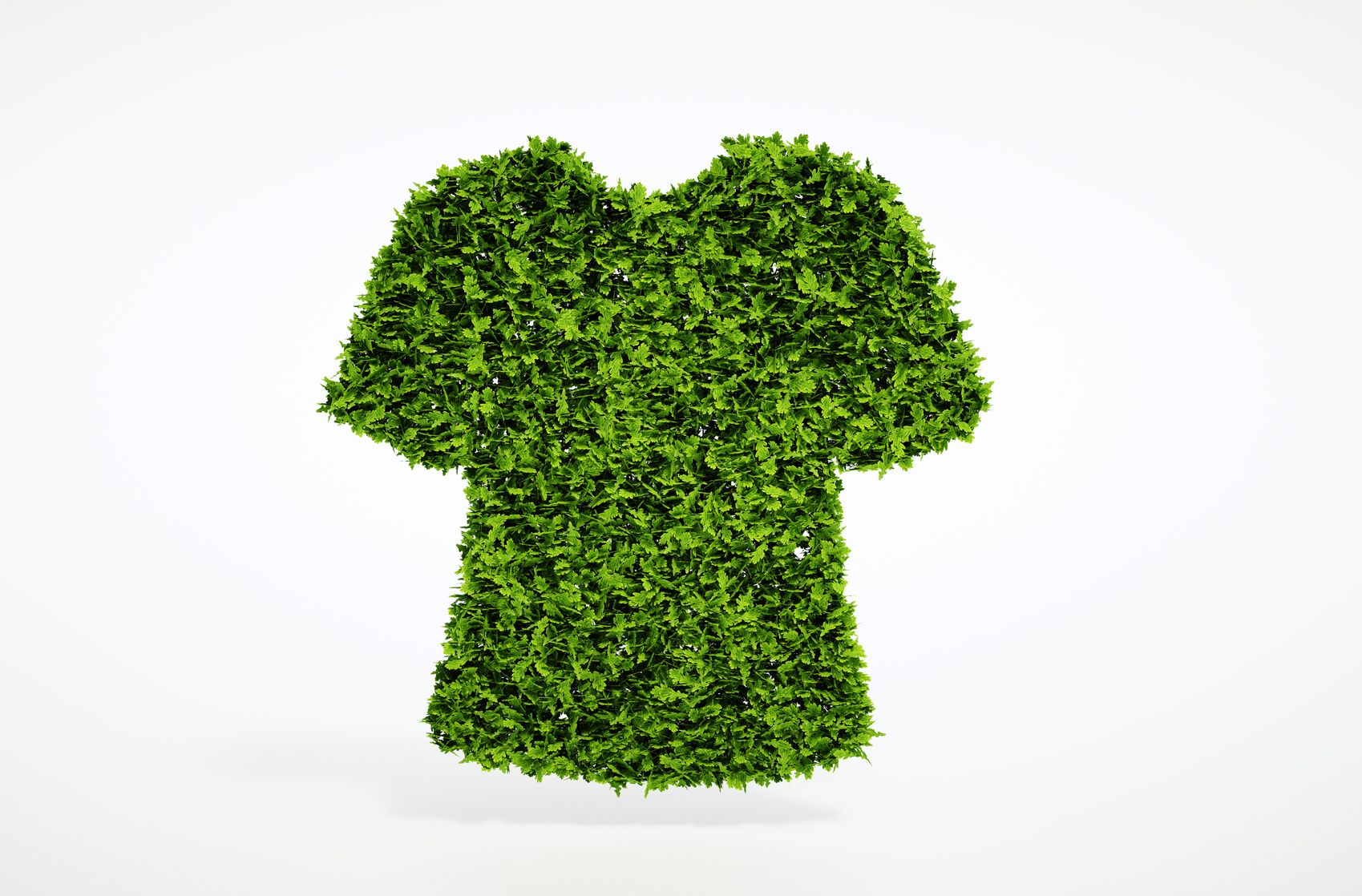
Innovative start-ups are also making progress in circular textiles. Renewcell created Circulose®, a material composed completely of recycled textiles that can be utilized to make new clothing without sacrificing quality. Resortecs provides sewing threads that dissolve during recycling, simplifying disassembly and facilitating garment recycling.

Together, these advancements in fabric technology and circular design are reshaping the fashion industry, ensuring a more sustainable and efficient future. As we look to the future, the continued exploration and adoption of novel fabrics will push the industry toward a more ethical, sustainable, and innovative path.
Internet of Things (IoT)
The IoT describes a network of objects - the ‘things’ - that are embedded with technology to allow the exchange and connection of data over the internet. This is one of the most exciting, emerging technological trends in the fashion market.
Year after year, everyday fashion continues to improve to reflect the realities of our daily lives. From a great emphasis on comfort to using new and exciting fabrics, the fashion industry has had to keep up the pace in adapting to the demands of contemporary life. This has been seen most clearly in the exciting advancements in apparel technology and wearable gadgets. These have gone as far as affecting how we experience our surroundings and interact with others and our bodies, giving the word comfort a whole new meaning.

Smart clothing, wearable spaces, multi-functional designs, and responsive sportswear have all massively developed over the past three years. As our "real" lives become increasingly mixed with a virtual existence, many designers have been experimenting and pushing the limits of what wearability means.
The Internet of Things (IoT) enables data sharing, inventory management, security, and increased efficiency and productivity. Many businesses consider IoT in improving their customer experience, by allowing customers to literally take the internet and data sharing with them day-to-day.
This includes apparel with digital capabilities, like smart clothing, wearable spaces, multi-functional designs, responsive sportswear, and more. Starting with the humble smartwatch, dominated by brands like FitBit and Apple, wearable technology dominates the fashion accessories market.
Meanwhile, Fuseprojects' power suits help the elderly suffering from muscle dystrophia to walk, stand, and stay active for longer periods. All of this data will come in handy for doctors and health providers to help their patients.
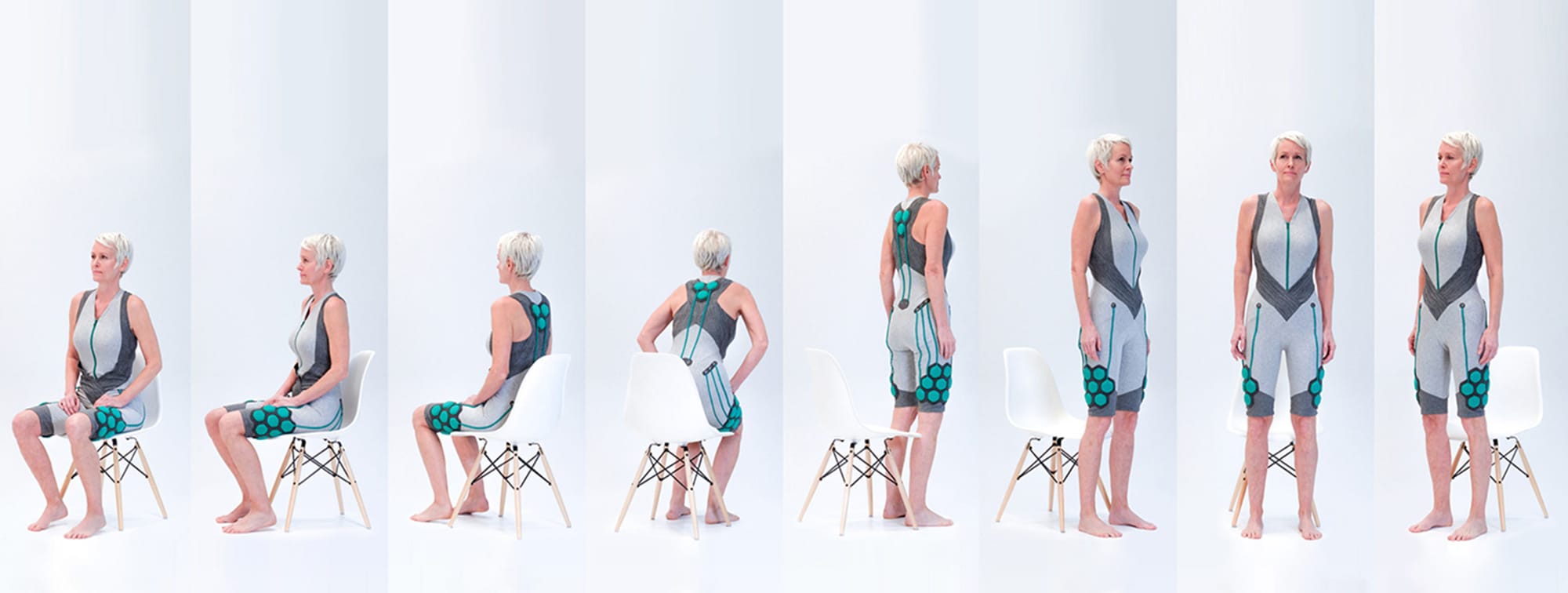
Another interesting example of the Internet of Things being incorporated into apparel is LOOMIA. The San Francisco-based textile company creates soft flexible circuits that can be embedded into textiles for heating, lighting, sensing, or data-tracking applications.
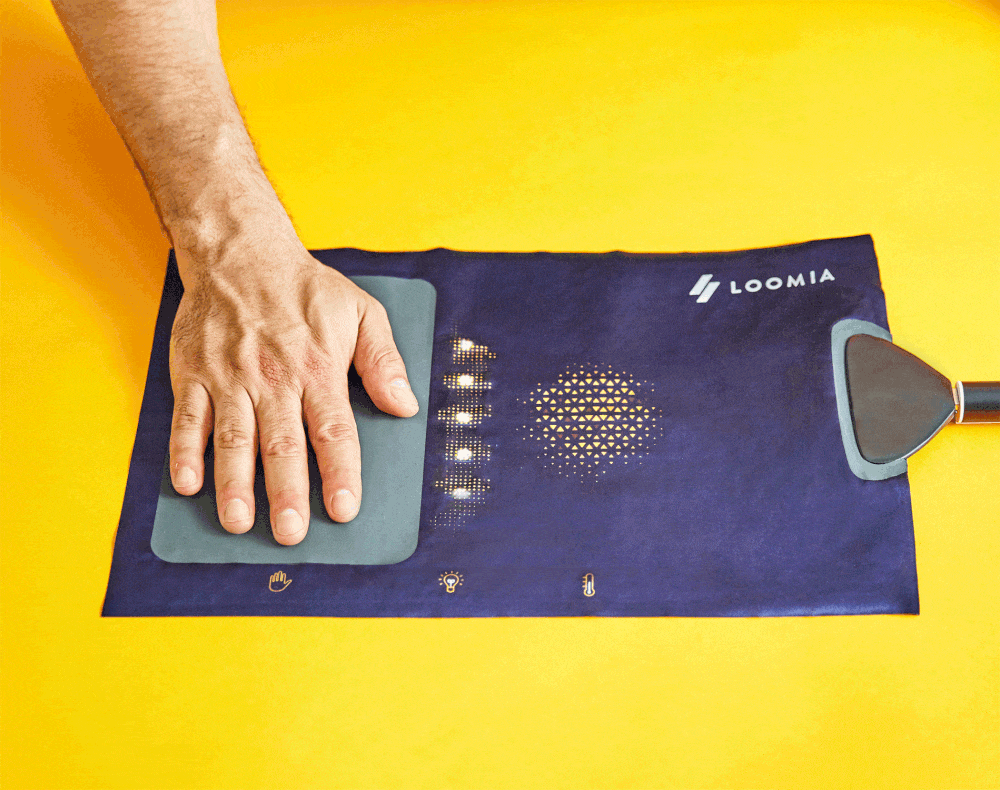
Brands such as Nike are experimenting with IoT-enabled footwear. Their self-lacing Adapt BB sneakers not only provide a perfect fit, but they also connect to a smartphone app to track usage statistics and customize settings.
Wearable X's Nadi X Yoga Pants are another noteworthy example; they include sensors integrated into the pants that vibrate subtly to assist users in maintaining ideal yoga poses. This invention provides a customized yoga instructor experience and is a perfect example of how IoT can be easily incorporated into fashion for both practicality and health.

By adapting to IoT technologies into clothing, the fashion industry is making products more useful, improving the user experience, and promoting sustainable practices.
Sign up for our FREE membership and get access to
All premium articles
E-courses and ebooks
Ad-free experience
Tech pack templates
Rapid Data Analysis for Quick Adaptation
Rapid data analysis, for quick adaptation, is a way for businesses to quickly adapt their business fragments (such as the supply chain) quickly and efficiently by using large amounts of data to support this adaption.
Thanks to the new software tools available on the market, brands, and factories can receive real-time feedback and alerts from companies about defects or damaged goods. This helps them save money, eliminate waste, and deliver adequate products at the right time. It also lets them maximize customer satisfaction by recognizing potential business threats instantly.
One example is management software like Delmia Works. Enterprise resource planning (ERP) software is used in manufacturing for monitoring and collecting production data in real-time, as products are being made.
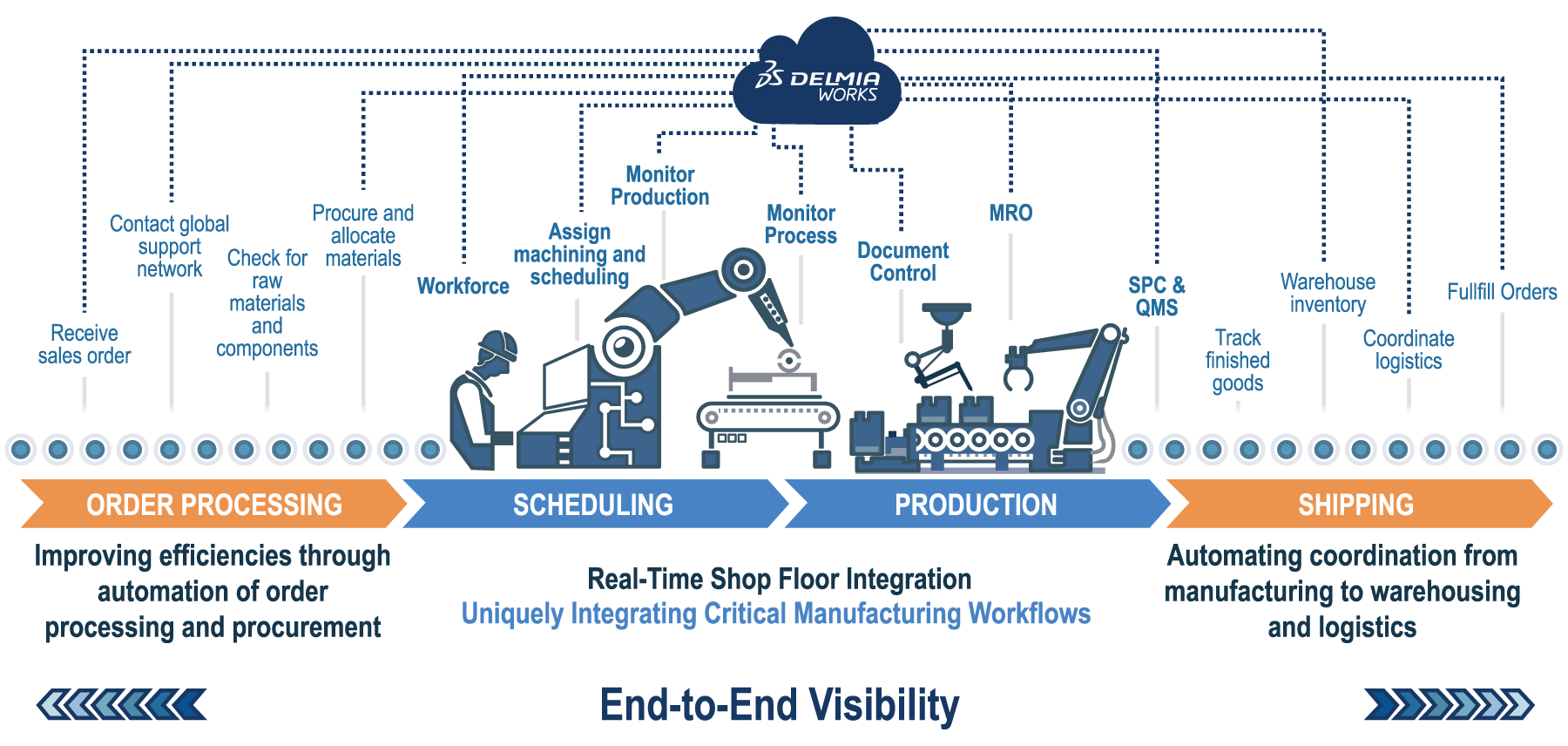
Although artificial intelligence has generated a massive quantity of data analysis insights and trends for many years, the trend will continue to rise in 2024, and as machine learning algorithms get more creative, smart, and clever, they will be asked to handle an even bigger task.
Not only can AI and machine learning algorithms analyze data faster than ever before, but they can also cope with more complicated data from videos, photos, and text. For many businesses, the combination of artificial intelligence and natural language processing is redefining how text data is processed and dealt with.
In the case of optimizing communication and production with factories, PLMBR helps streamline and automate this entire process. Its cloud-based software allows everyone in design teams and factories to learn about changes in tech packs in real time.
This eliminates the entire manual process and the constant emailing, making tech pack creation 70% faster than traditional methods. This has been shown through the new Illustrator Plug-In, which imports designs via cloud-based software in seconds.
This is key in promoting PLM techniques that manage a business sustainably, across numerous distribution channels. The PLMBR app enables fashion teams and their manufacturers to manage product development in real time.
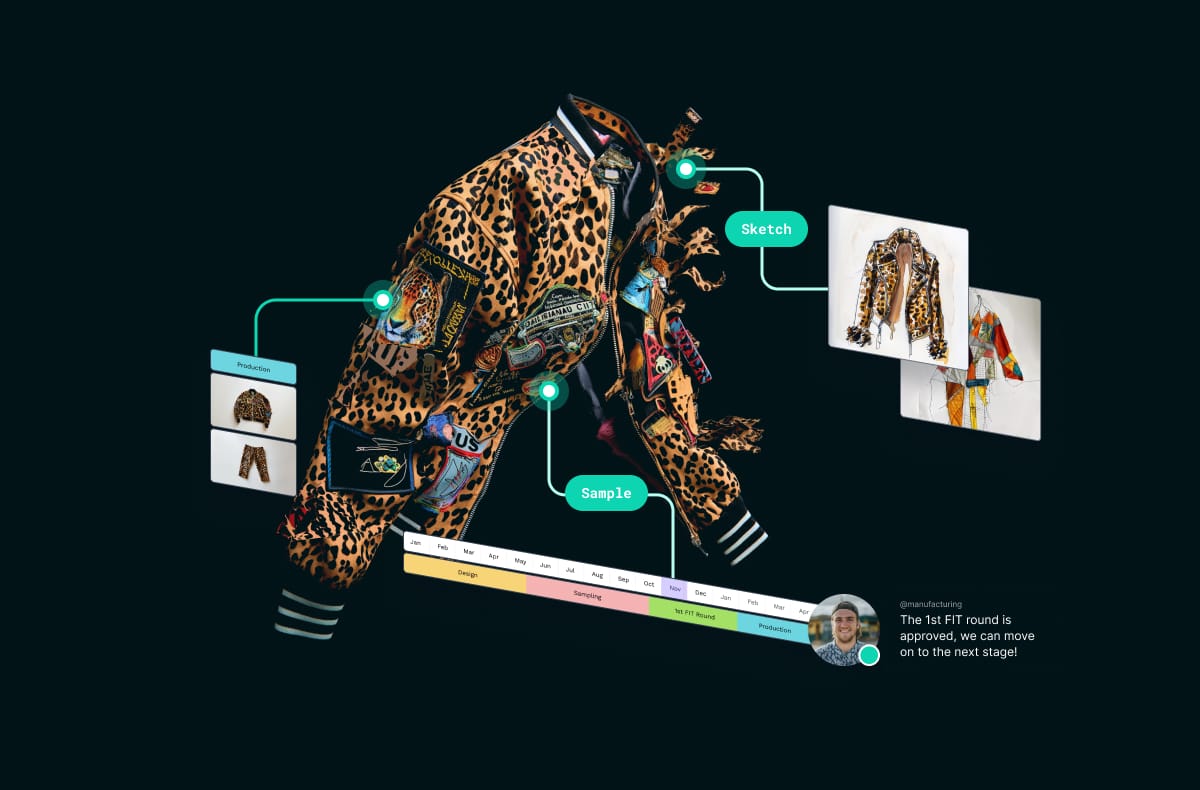
This highlights how rapid data analysis can help companies adapt quickly when needed. As seen during COVID-19, the need to adapt and overcome has been paramount for brands to survive. Thus, using a rapid data tool like Techpacker can help improve team collaborations and optimize product development and production lifecycle through just one intuitive software choice.
Mobile Commerce
Mobile commerce is fast expanding and becoming a key component of the fashion industry. From in-app shopping to digital wallets, mobile technology is reshaping the way we shop. According to Statista, mobile e-commerce has steadily increased over time, rising from 43% in 2018 to a projected 63% by 2028.
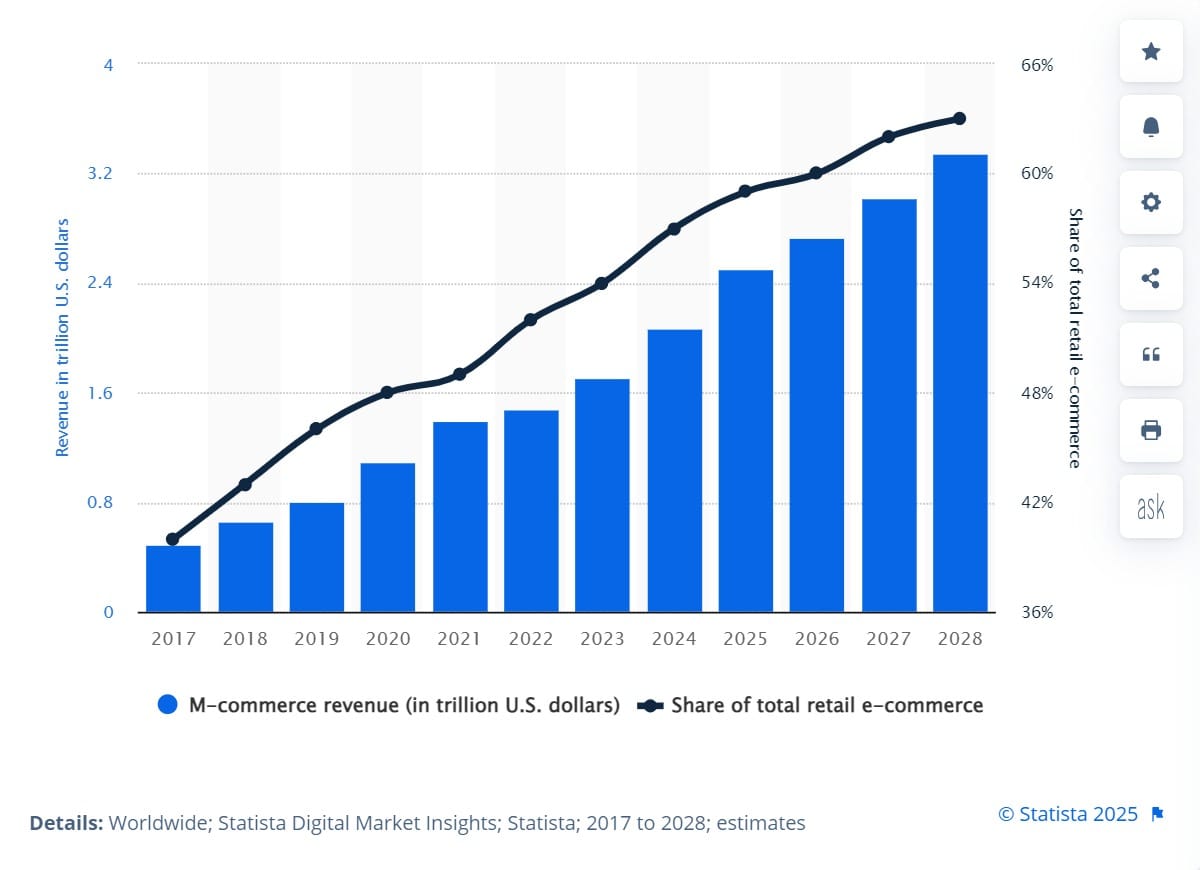
Mobile purchasing is becoming faster and more intuitive because to innovations such as tap-to-pay technology, voice-assisted shopping via AI-powered tools (for example, Amazon Alexa), and one-click checkouts. Digital wallet choices such as Apple and Android Pay are continually improving with new technology such as fingerprint and facial recognition, putting them on track to become the default payment method for retail purchases. In fact, BigCommerce reports that two out of every three millennials prefer to purchase online rather than in-store.

If, on top of e-commerce growth, we throw social media into the mix, (like Instagram's shopping feature and TikTok’s Live Shopping brands can be present in their customers' favorite channels with a fully integrated digital commerce offering. This gives them greater visibility and provides them with more opportunities to make a sale.
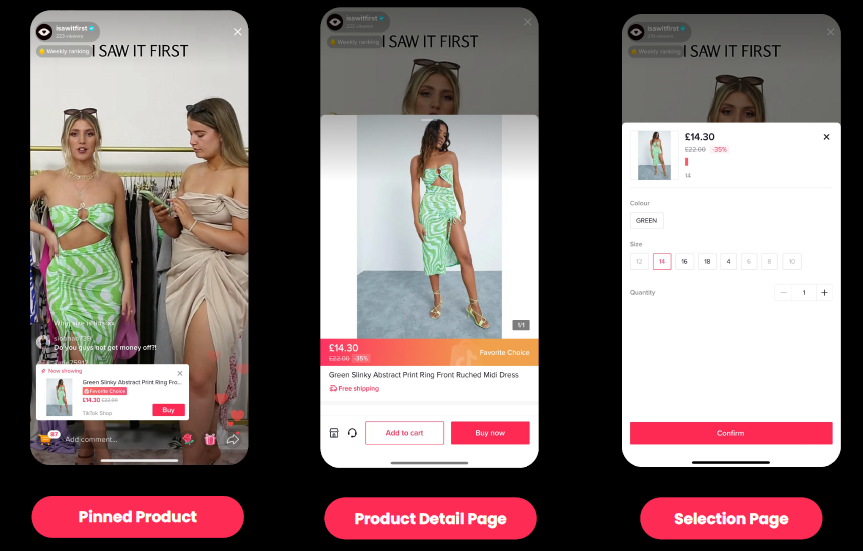
Likewise, sustainable fashion apps like Vinted and Depop have taken the market by storm, replacing traditional avenues like eBay and Gumtree for selling second-hand fashion. These mobile sales sites have revolutionized the online sales industry, demonstrating how mobile commerce is innovating every aspect of the fashion industry.
Mobile commerce isn’t just a convenience—it’s a critical avenue for brands to meet customers where they are: on their phones, scrolling, searching, and shopping.
The Metaverse and Virtual Fashion
The fusion of the digital and real worlds is one of the most fascinating developments in the fashion industry. With the rise of the Metaverse and virtual reality (VR), fashion firms are developing new, immersive retail experiences that go beyond online purchasing—they are reinventing what it means to shop, interact, and engage with fashion in a digital world.
In recent years, augmented reality (AR) and virtual reality technology have joined to allow shoppers to try on clothing without physically entering a store. This virtual try-on system, which incorporates tailored measurement functionality and augmented reality, improves accuracy and enables users to picture things as if they were physically trying them on. Nike and Gucci are utilizing these technologies to build immersive virtual showrooms where clients may browse and purchase digital clothes or real-world designs.
OBSESS is a platform that enables brands and retailers to design and serve 3D, 360-degree shopping experiences on their websites, mobile apps, and social channels using a 3D Commerce Cloud.
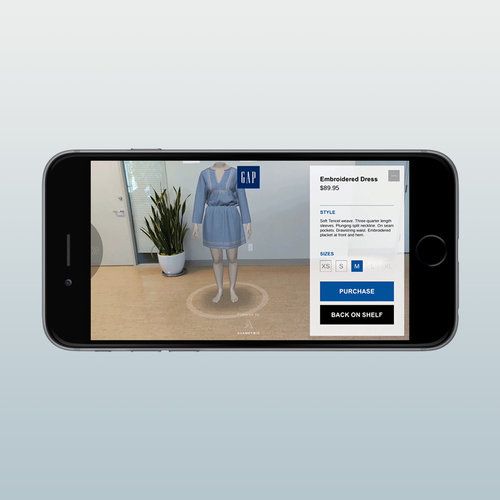
VIRTUSIZE also enables online fashion retailers to virtually illustrate the size of their products, to find the accurate fit for the garments their customers choose.
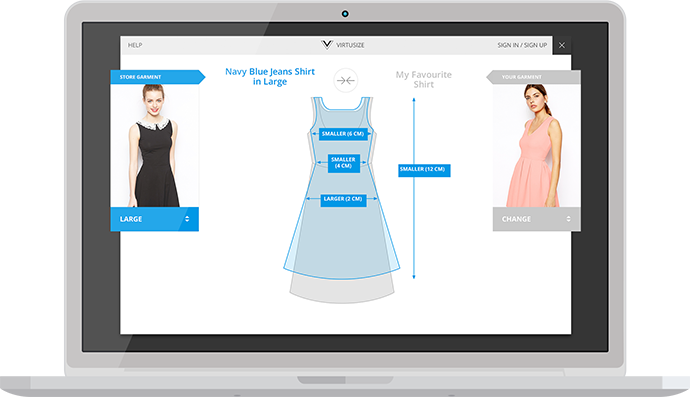
Another prime user of AR/VR technology is EFI Optitex which has greatly improved the expensive and lengthy process of finding an adequate fit. They’ve shown how to take the essential components of a design, like flat sketches and technical patterns, which can then be morphed into simulated 3D renderings. This then allows users to quickly adjust for cutting, loosening the fit, and making all the necessary adjustments in real-time.
Other new 3D rendering technologies include CLO. The tool allows brands to edit designs at the moment and instantly review changes. This can help improve the quality of designs by checking the silhouette and fit sooner in the development process. This way minimizes waste and reduces errors in the sample before finalization.
Selling digital clothing is getting more popular too. People will be able to purchase digital apparel from a new Meta-created store and use it to outfit their Instagram, Facebook, and Messenger avatars. There are plans to broaden this so that independent designers may market their work.
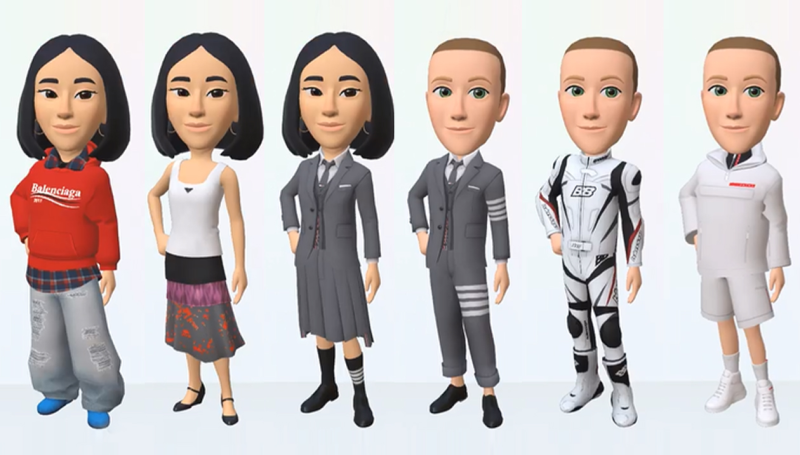
The concept of experiential retail is also evolving with the integration of VR and AR technologies. Fashion brands are creating immersive retail environments that blend physical and digital elements, enhancing the shopping experience and creating lasting emotional connections with consumers. For example, Nike's House of Innovation stores feature interactive zones where customers can test products in real-world scenarios and customize sneakers. Similarly, Lululemon has transformed its stores into spaces that combine retail with wellness, offering yoga studios and meditation spaces alongside its product offerings.
Brands like Burberry are using interactive mirrors and mobile integration to provide personalized in-store experiences, allowing customers to virtually try on items or receive curated styling tips. The concept of digital fashion showrooms is becoming more widespread, allowing brands to gauge market appetite before production even begins.
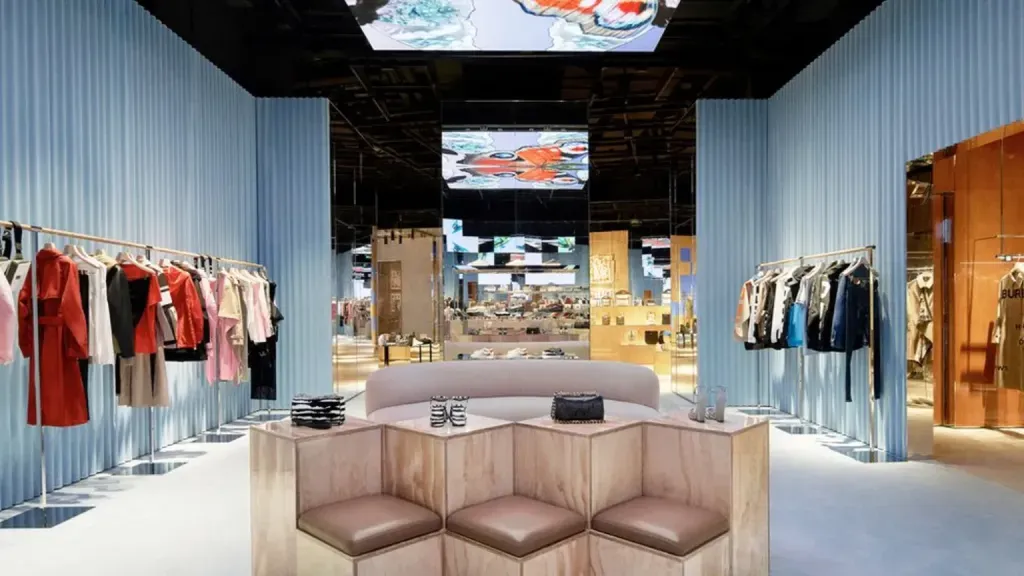
As we move further into the Metaverse, the boundaries between the physical and digital worlds will continue to blur, and the fashion industry will have to adapt. Virtual fashion, immersive shopping, and experiential retail are shaping the future of the industry, offering customers new, innovative ways to interact with their favorite brands. From virtual try-ons to digital wardrobes and experiential stores, the future of shopping is no longer limited to physical spaces—it’s a dynamic, hybrid experience that exists in both the real and virtual worlds.
Online Vector Editors
New Adobe Illustrator alternatives are gaining popularity. These are great choices if you're new to designing using graphics design software. Or if you don't have access to Illustrator or Sketch, all you need to do is simple vector graphics editing.
Online vector editors allow you to download, embed or simply share a public link of your designs with the world in web-friendly SVG format and can be accessed from anywhere on any machine. Vectr is a free, cloud-based tool that’s great for beginners or those working on simple design tasks. Boxy SVG Editor offers more advanced features like path editing and text styling, making it perfect for detailed projects. Its compatibility with SVG files makes it a good choice for web and mobile design.
Repsketch stands out for fashion designers as it offers pre-built clothing templates with customizable details like collars, sleeves, and pockets. Repsketch’s AI-powered feature allows users to convert 2D sketches into 3D images, helping designers visualize their creations before production. This feature saves time and reduces manual labor, making the design process faster and more efficient. Repsketch is a helpful tool for those in the fashion industry looking to streamline their workflow.
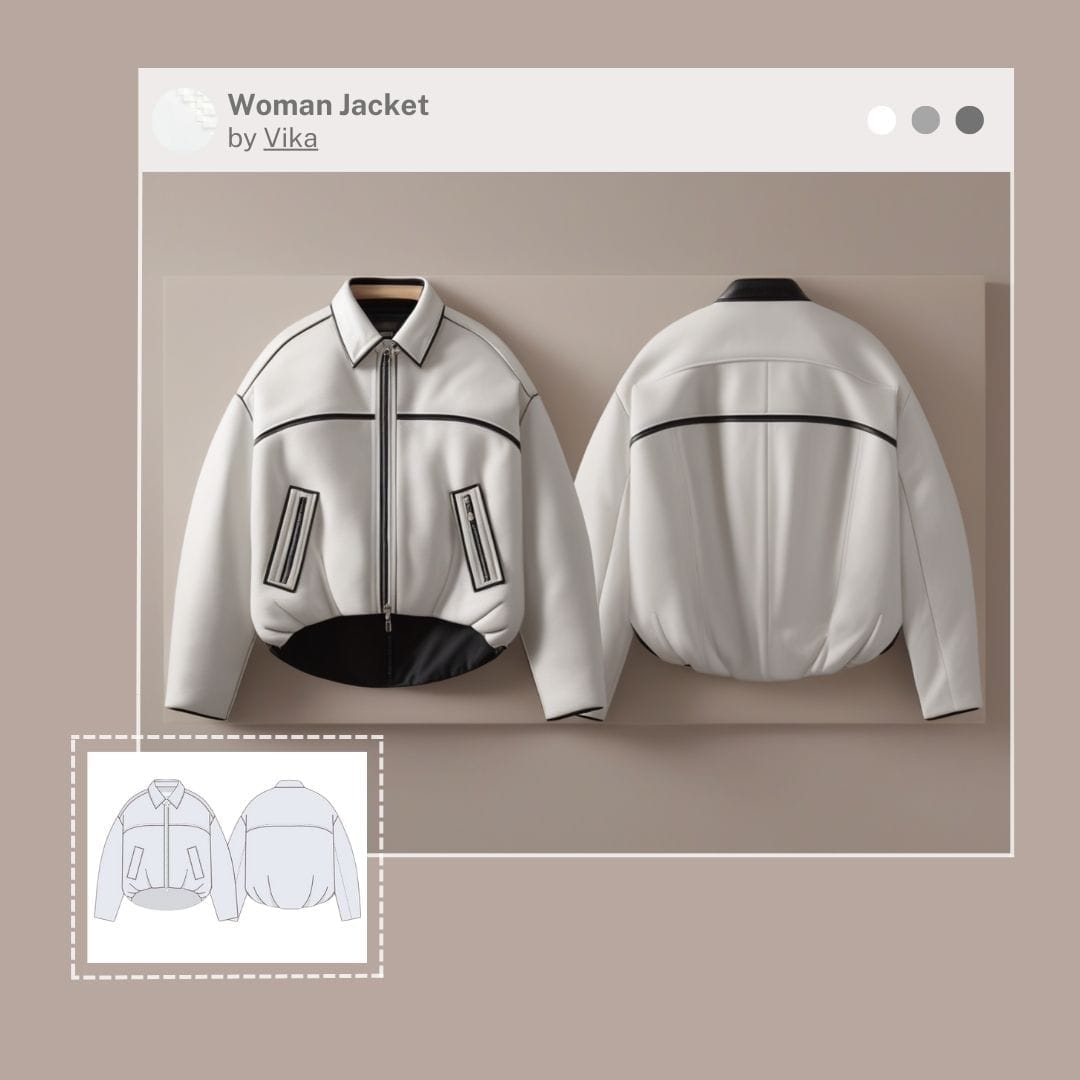

These online vector editors are designed for ease of use and collaboration. They allow designers to create, share, and edit their work efficiently, all while using web-friendly SVG formats. Many of these platforms also include options for downloading or sharing links to designs, making collaboration seamless.
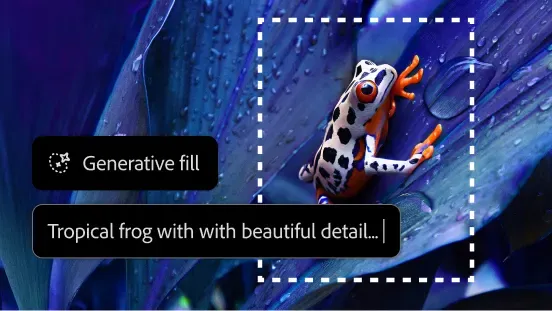
In the last few months, several updates and new features have been added to vector design software. Adobe’s Firefly Vector AI model has been integrated into Illustrator, adding features like Generative Shape Fill and improved Text to Pattern.
Inkscape, an open-source vector editor, released version 1.4, bringing new accessibility and customization features. Adobe also introduced “Project Turntable,” a tool that allows users to rotate 2D vector drawings like 3D objects, simplifying the process of creating 3D-like effects.

These updates show how the vector design industry is evolving with new technologies that enhance functionality and user experience. These tools are making it easier for designers to create high-quality designs, collaborate with others, and streamline their workflows.
3D Printing
Since the advent of 3D printers, many brands, both big and small, have been looking into the possibilities it holds for on-demand production. This will create new avenues for customization, sustainability, and creativity.
Many fashion brands are embracing 3D in their collections, from accessories to full looks.
For example, Chromatic 3D Materials and Anouk Wipprecht, a Dutch high-tech fashion designer, have launched a new futuristic 3D printed clothing that interacts with its surroundings via LEDs. According to Chromatic, the motion-activated design is one of the world's first garments to directly incorporate electronics inside 3D-printed elastomers.
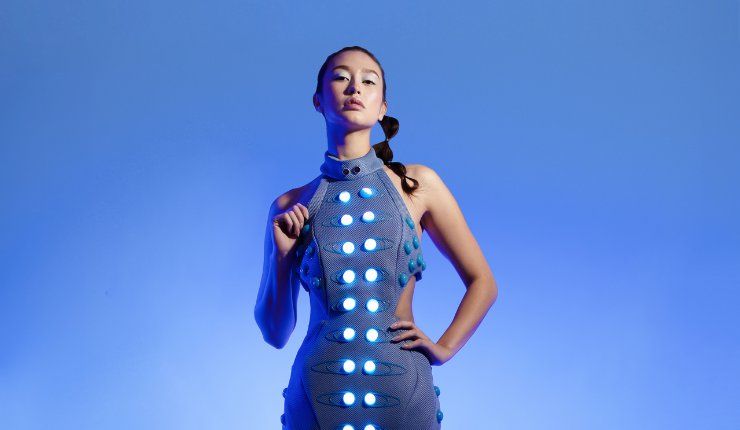
Despite the fact it takes many hours to create, it results in less waste and proves far less labor-intensive than other types of manufacturing. Indeed, printing garments on demand reduces fabric waste by about 35%. This minimal waste approach could provide valuable insights on how to reshape the current state of factories and align them with a more sustainable social and environmental focus.
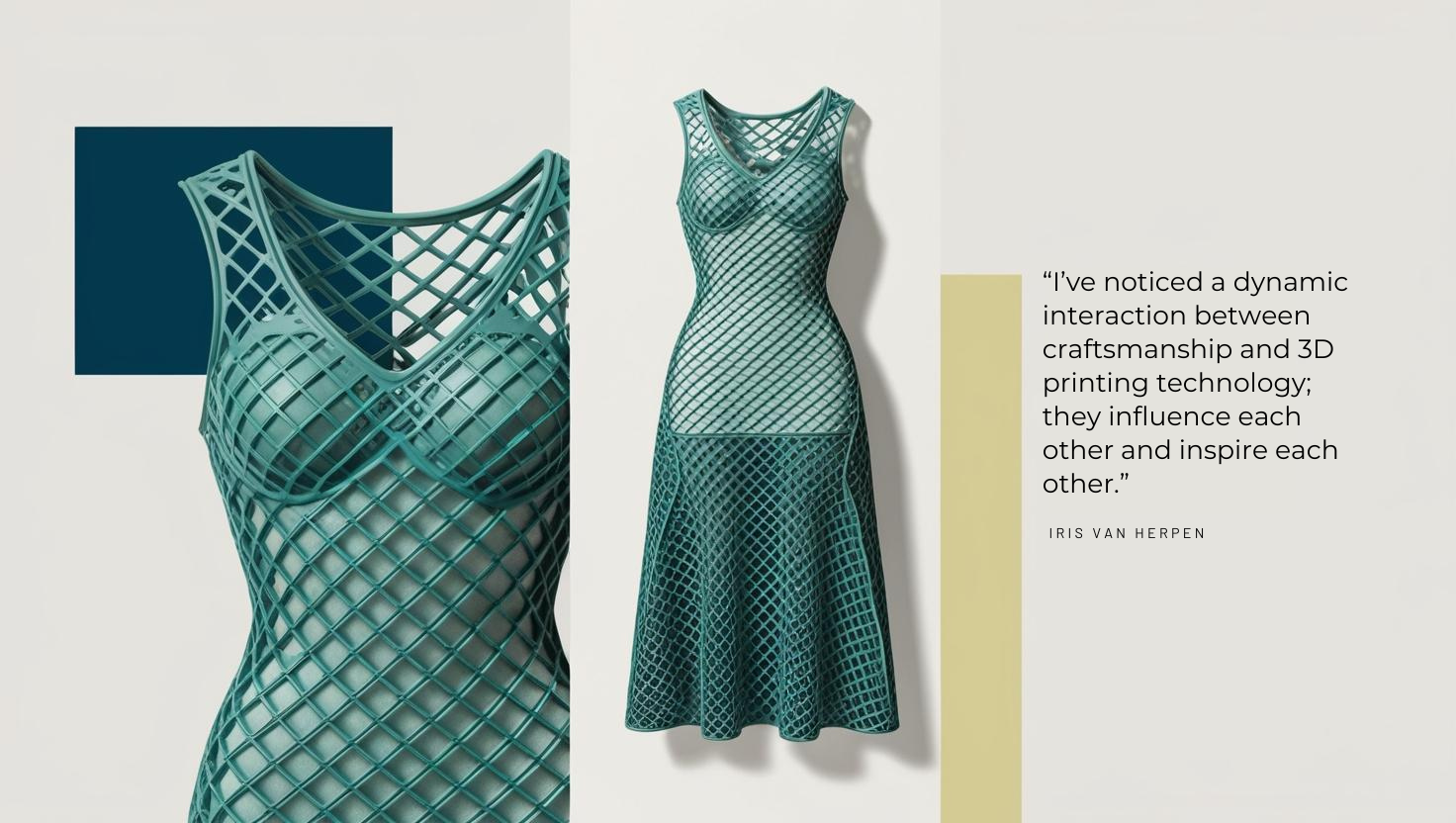
Read more in-depth about 3D printing technologies and their application
Zellerfeld's 3D-Printed Sneakers are another cool step forward in the business. This shoe brand only uses materials that can be recycled, so customers can recycle their old shoes and get a new pair. This helps the environment and cuts down on trash.
Nike collaborated with Zellerfeld to create the Air Max 1000, a footwear that is almost totally 3D printed. This revolutionary design demonstrates the possibilities of 3D printing in footwear, allowing for a mix of firm and flexible materials in various portions of the shoe to improve both performance and comfort.
Digital knitting has also been making great strides in the 3D printing world, and it offers a myriad of customization possibilities. For example, manufacturers like Shima Seiki can turn cones of yarn into a full, seamless garment in less than an hour.
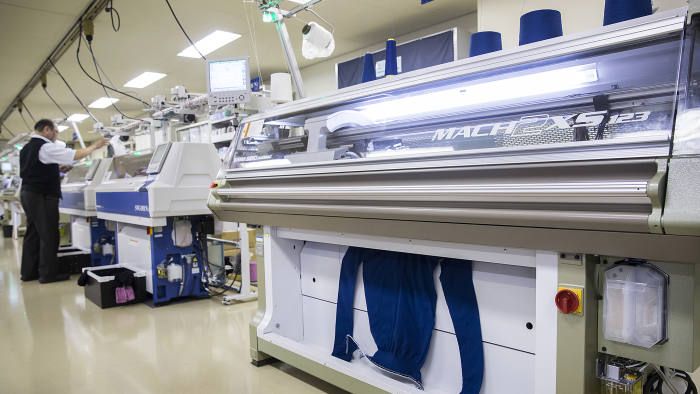
Stratasys is using innovative partnerships and cutting-edge technology to push the limits of 3D printing in the fashion industry. The company collaborates with designers such as Ganit Goldstein to create colorful, multi-textured clothing and accessories using multi-material 3D printing, demonstrating the creative possibilities of this cutting-edge technique.
Additionally, Stratasys is aiming to promote sustainability in the fashion industry by introducing its Direct-to-Garment (D2G) printing technology. With the recently unveiled D2G feature, the J850 TechStyle fashion 3D printer can now produce accurate, superior prints straight onto fabric, cutting waste and providing a sustainable substitute for conventional techniques. In addition to expanding the creative options, this development supports the industry's move toward ecologically friendly production methods.
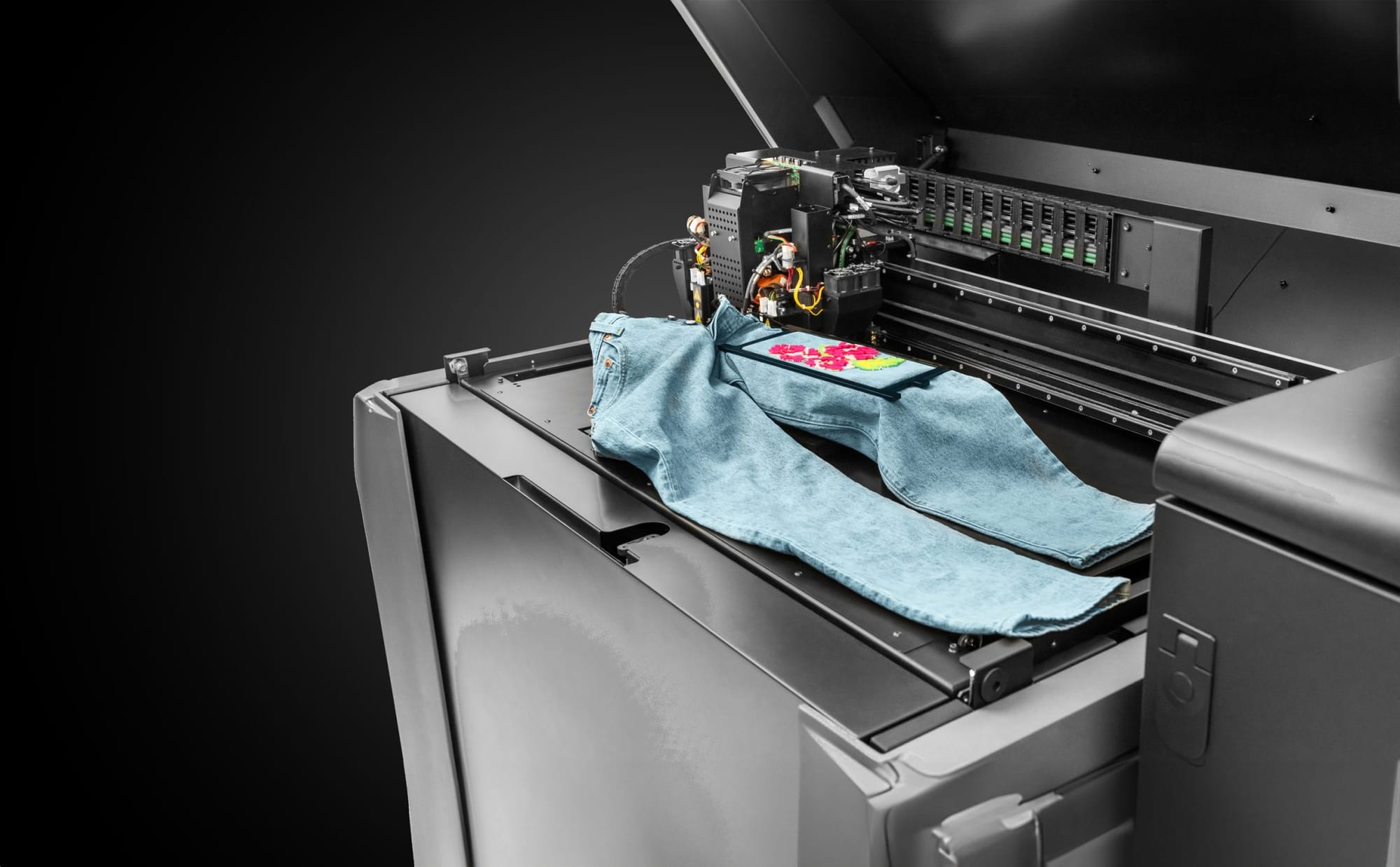
Blockchain
A blockchain is a great tool for transparency, traceability, and efficiency in the supply chain. It allows all of its members, from carriers and banks to intermediaries and suppliers, to be connected and exchange information, documents, and data, directly and securely.
But what is blockchain and how does it work?
Blockchain is mostly used as a record-keeping technology behind Bitcoin and digital currency. "Blocks" on the blockchain are made up of digital pieces of data that store information about transactions like the date, time, and dollar amount of your most recent purchase, as well as who is participating in the transactions. However, they also store information that distinguishes them from other blocks, using a unique code called a hash. (More about blockchain from Investopedia.)
This can be used to efficiently trace and keep records of clothing apparel and supply chains through technology like track-and-trace and inventory management.
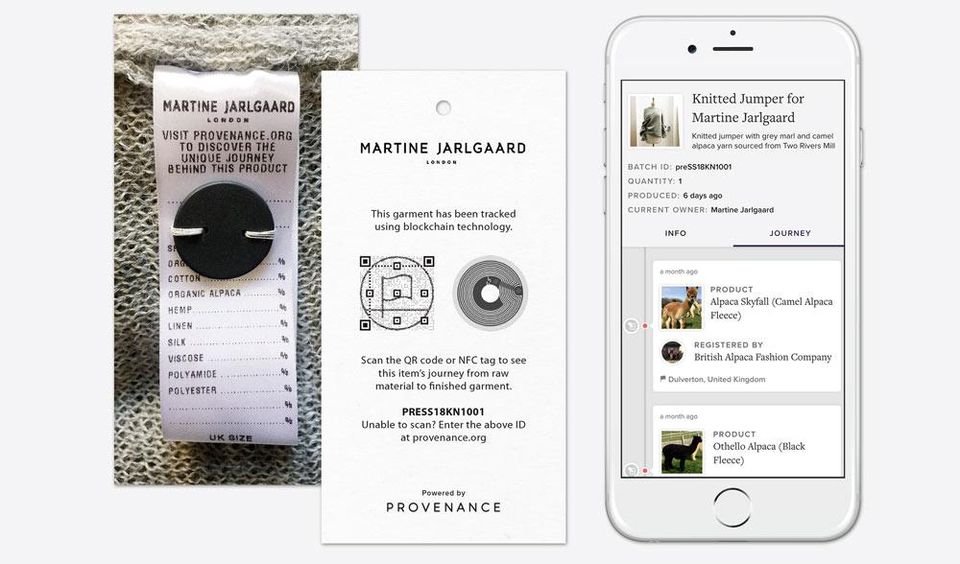
The blockchain solution creates a physical digital link between products and their digital identities on a blockchain. Just like with digital currency, Blockchain offers a cryptographic seal or serial number that acts as the physical identifier which is linked back to the individual product's "digital twin", as explained by Forbes magazine.
This technology has been taken advantage of by TextileGenesis, which uses the technology to keep a record of every stage of production. They say this will help to keep their supply chain more transparent, as well as encourage a wider push towards sustainability.
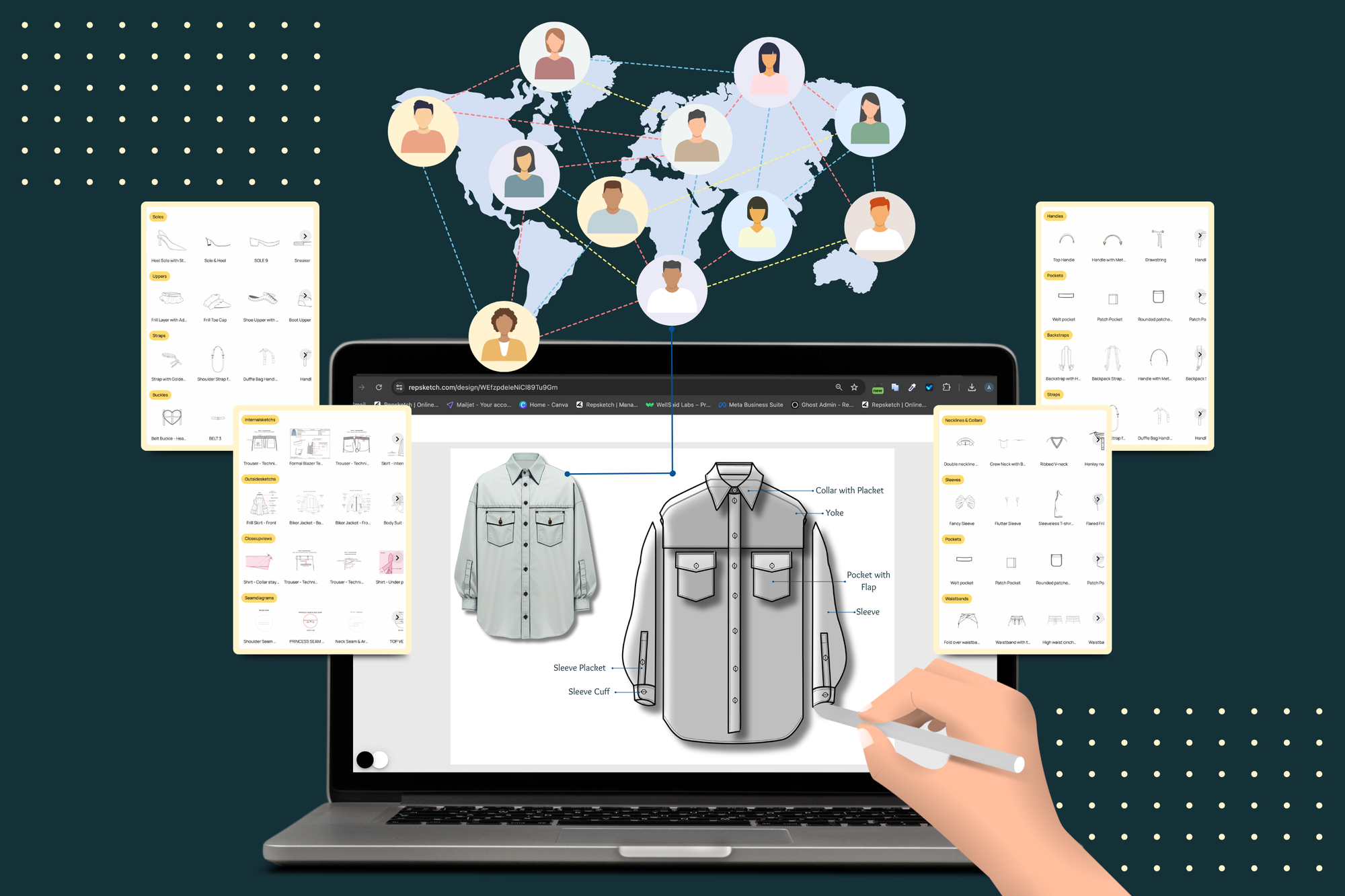
In addition to blockchain's role in traceability, the fashion industry is embracing product passports—digital documents that store essential information about a garment's materials, production methods, origin, and care instructions. By integrating technologies like NFC or QR codes, each garment is assigned a product passport, which can be accessed digitally, providing a comprehensive history of the item.
A leading example is EON, which links garments to their digital profiles through QR codes, offering detailed information about the product’s lifecycle. This empowers customers to make better choices about care, repair, and end-of-life management. Similarly, startups like Circular Fashion and Circularise are pioneering digital product passports that track garments beyond the point of purchase, enabling reselling and recycling.
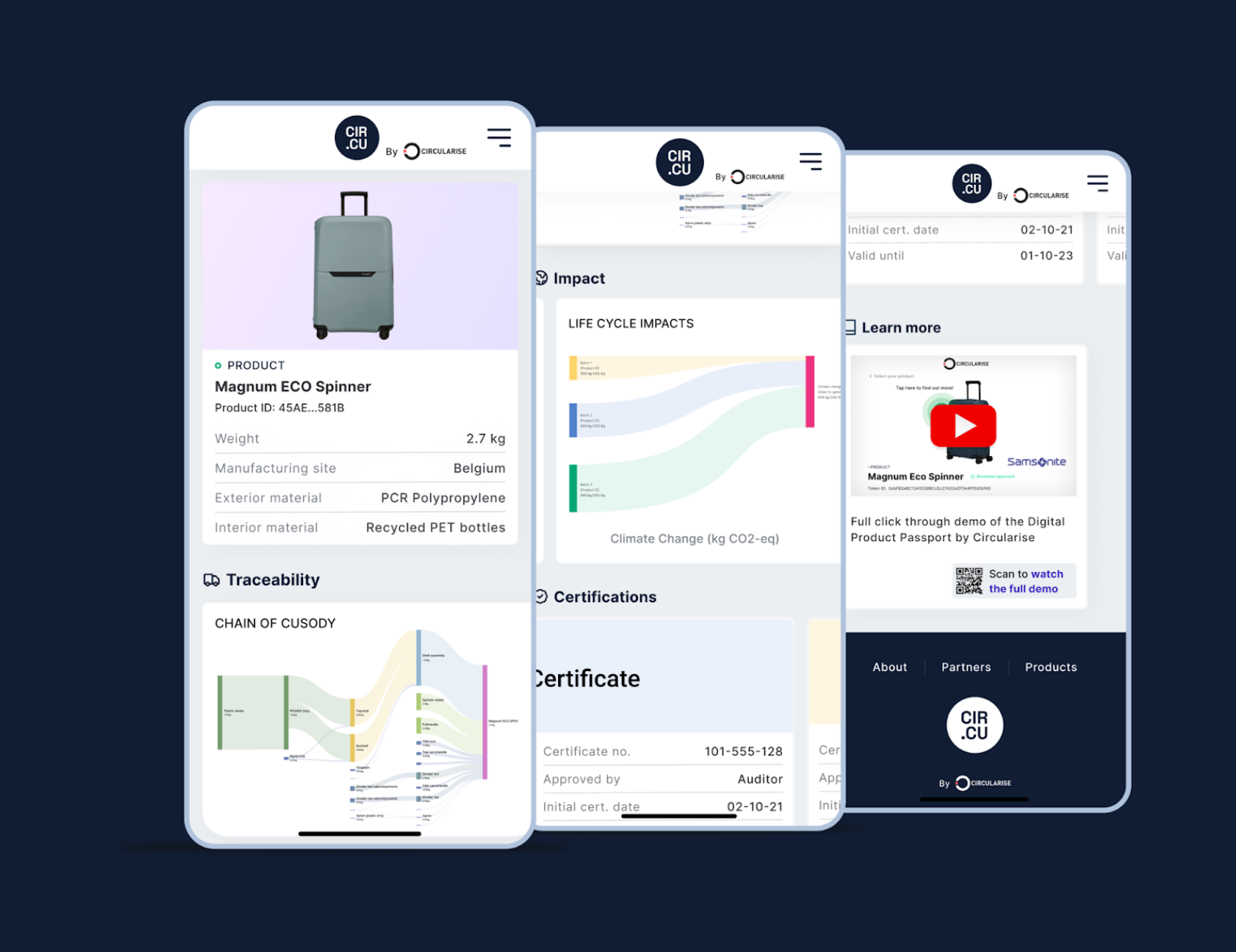
Major brands, including H&M and Adidas, are piloting digital product passports to enhance garment longevity and minimize waste. Meanwhile, the European Union’s Green Deal initiative aims to introduce mandatory product passports for textiles, promoting sustainability across industries.
By combining blockchain with product passports, the fashion industry is laying the foundation for a more transparent, sustainable, and circular future—ensuring that every garment tells its full story, from design to disposal.
Other basic FAQ's
1. How exactly is artificial intelligence being used in fashion beyond just chatbots and personalization?
Artificial intelligence in fashion goes far beyond simple recommendation engines. Today, AI supports trend forecasting, automated design generation, virtual try-ons, and real-time inventory optimization. For example, predictive analytics help brands avoid overproduction by aligning styles and quantities with actual demand. Generative design tools are also cutting development times from months to weeks. If you want to explore this further, check out our guide: How Artificial Intelligence is Revolutionizing the Fashion Industry
2. What are some of the most promising sustainable and high-tech fabrics that could replace traditional textiles in the coming years?
Beyond organic cotton and recycled polyester, 2025 is seeing a surge in lab-grown leather, spider silk, smart fabrics with sensors, and even 3D-printed textiles. These materials not only reduce environmental impact but also unlock performance benefits such as temperature control or biometric tracking. Circular textiles, which are designed for recycling or biodegradation, are also gaining traction. Learn more in our detailed post: Top Sustainable and Eco-friendly Fashion Materials of 2024.
3. How is the Internet of Things (IoT) transforming everyday fashion into connected and functional clothing?
IoT-enabled fashion means your clothes can now collect, exchange, and respond to data. From Nike’s self-lacing sneakers that sync with mobile apps to yoga pants with posture-correcting sensors, wearables are merging utility with design. IoT also improves supply chain visibility by tracking garments in real time. For an in-depth look at this space, see: How IoT is Redefining the Future of Fashion: From Smart Fabrics to Connected Garments.
4. In what ways can 3D printing reduce waste and change how fashion brands manufacture clothing?
Unlike traditional methods, 3D printing allows brands to produce garments on demand, cutting fabric waste by up to 35%. It also opens the door to complex, customizable designs—like Zellerfeld’s recyclable sneakers or Stratasys’s direct-to-garment printing on textiles. This technology minimizes sample production, making fashion more sustainable and cost-efficient. To dive deeper, read: The Indefinite Guide To 3D Printing In Fashion.
5. Why is blockchain becoming such an important tool for supply chain transparency in fashion?
Fashion supply chains are complex and prone to greenwashing. Blockchain ensures traceability at every stage—from raw material sourcing to final sale—by creating tamper-proof digital records. When paired with product passports (QR codes or NFC chips embedded in garments), consumers gain access to information about a product’s origin, care, and recycling options. Read more about how open collaboration supports these innovations here: Importance of Open Source Product Development in the Fashion Industry.
6. How are new digital tools helping designers shift from traditional sketching to faster 3D design workflows?
Modern design platforms now allow fashion teams to move from flat 2D sketches to 3D prototypes without needing multiple physical samples. For instance, Repsketch helps designers convert flats into 3D visuals instantly, while online vector editors make collaboration seamless. This reduces errors, speeds up approvals, and cuts down on waste. Learn more in our guide: How to Convert 2D Flat Sketches to 3D Designs.
7. What challenges do fashion brands face when adopting new technologies like AI, IoT, or 3D printing?
While technology adoption brings efficiency, it also introduces hurdles such as high upfront costs, integration with legacy systems, and the need to retrain teams. Some brands also face issues with data privacy, while others struggle to align fast-paced innovation with sustainability goals. For a bigger picture of these hurdles, see our analysis of Top 8 Fashion Industry Challenges in 2025.


